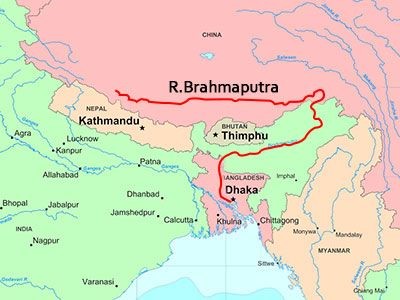Scotland of the East
“Welcome to the Scotland of the East.” The battered road sign on a hairpin curve on India’s National Highway 40 looked incongruous amid the stands of bamboo and sub-tropical vegetation. For a moment, I wondered if I was hallucinating. The scenery didn’t look any different from that Stephanie and I had seen for the past hour as our shared taxi labored up the twisting highway from the Brahmaputra valley into the Khasi Hills, passing villages that looked much like other villages in northeast India. No medieval castles shrouded in mist. No sweeping views of lochs and glens. No sheep (only the usual cattle and goats on the road). Not a single sprig of heather. And definitely no kilts. But I wasn’t dreaming. The sign contained the imprimatur of the Meghalaya Tourism Board, so at least someone thought we were in Scotland.
We were on our way to Shillong, the capital of Meghalaya, the small, hilly state sandwiched between western Assam to the north and Bangladesh to the south. The end of the first Anglo-Burmese War in 1826 left the British East India Company in control of Assam and the northeast. The company depended on the river system for transportation, with steamers from Kolkata and other ports carrying troops, supplies, merchants and missionaries up the Brahmaputra. The company’s regional administrator, David Scott, devised a plan to build a road from the plains of Bengal through the hills to the Brahmaputra to provide an alternative route that would not be affected by annual flooding. After a four-year war with the Khasi, the British took control of the hill country south of the Brahmaputra and posted a political agent to the settlement of Cherrapunjee. In 1864, the administration established a hill station at Shillong. A decade later, it became the capital of the province of Assam, and retained its status until 1972 when it became capital of the newly-created state of Meghalaya.
The “Scotland” story goes something like this (there is no official version, so I am taking literary license). Reaching the crest of a hill, the East India Company agents, weary from their journey from the sweltering lowlands, looked out through the drizzle on a landscape of grassy, treeless hills, mountain streams and clear lakes. “Reminds me of Ben Lomond,” said one. “Nay, Speyside,” replied another. Either way, it looked like Scotland, or as close to Scotland as homesick, tired and dehydrated East India Company agents could imagine. History—or at least the Meghalaya Tourist Board road sign—would have been different if those first agents had come from the Lake District, Yorkshire, Northumberland or North Wales.
Whatever the origin of the Scotland label, it stuck. At an elevation of almost 5,000 feet, the hill station of Shillong had a mild climate—cool and rainy in summer, cool and dry in winter—offering welcome relief from the searing temperatures of the lowlands. The British planted pine trees, and built Victorian bungalows, churches, a polo ground and a golf course called Gleneagles. For half a century, Shillong resembled a transplanted British country town. Then India crowded in. Today, Shillong with a population of 150,000 is (by Indian standards) a large town; its suburbs, sprawling across the hills, add another 200,000 to the metropolitan area. Khasis make up most of the population, with other northeastern tribes represented, as well as Assamese, Bengalis and migrants from mainland India.
About half the population of Meghalaya, and two thirds of Shillong, listed themselves as Christian on the 2011 census. Protestant and French Catholic missionaries had followed the colonial administrators into the hill country and found willing converts among the tribal peoples, many of whom mixed Christianity with traditional beliefs. Not surprisingly for the “Scotland of the East,” Presbyterians form the largest denomination; they built sturdy stone and timber churches in Shillong and other towns. Immigrants from Assam and mainland India have recently led to a resurgence of Hinduism with about one in four in Shillong listing Hinduism as their religion.
The Presbyterians win in the numbers game but it’s the Catholics who win the architectural prize for the Cathedral of Mary Help of Christians, situated on a hill a mile south of the center of Shillong. It is the principal place of worship for the Shillong Archdiocese, which has 33 parishes and an estimated 300,000 adherents. The cathedral stands out not only because of its Art Deco style but because of its color—a striking shade of blue, which also brands the schools, social service centers and shrine around the cathedral—and its foundation. Or rather, lack of foundation. Because the Shillong region is prone to earthquakes, the church was built on trenches filled with sand and has no direct connection with the rock. Theoretically, during an earthquake, the building can shift safely on the shock-absorbing sand.
We visited the cathedral with Ratul Baruah, the news editor of the English-language Meghalaya Guardian, whom I had met on the flight from Delhi to Guwahati. With its high arches and long stained-glass windows, the cathedral has been described as modern Gothic. By Catholic standards, its interior seemed uncluttered, with just a few large paintings and banners. The banners, explained Ratul, were in the Khasi language, indicating how the missionaries had adapted their religion to local sensibilities.
After the visit, Ratul took us for lunch at a restaurant owned by his friend, Raphael, an artist and local TV station owner. We talked about the vibrant local media scene; in addition to Ratul’s newspaper, three other English-language weeklies and newspapers in indigenous languages—Khasi, Jaintia and Garo—circulate in Meghalaya. I told Raphael I was curious about his name. “Well, I have a Khasi name,” he told me, “but my family is Catholic, so my mother had to give me a Christian name. Don’t you think Raphael is a pretty good name for an artist?”







